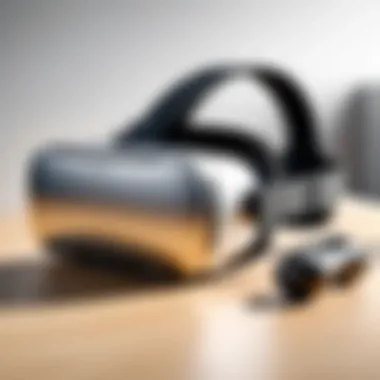Affordable VR Options to Explore in 2023


Intro
As virtual reality technology continues to grow, many consumers find themselves longing for immersive experiences without emptying their wallets. In 2023, several affordable VR options have entered the market, allowing tech enthusiasts and gamers alike to explore virtual worlds without compromising on quality. This guide seeks to illuminate these choices, presenting a thorough evaluation of budget-friendly VR headsets.
With a plethora of devices available, it can be challenging to discern which options deliver value and effectiveness. Thus, we aim to dissect various headsets, highlight their key features, discuss performance metrics, and weigh their cost-effectiveness. By examining different specifications, we hope to provide insight that guides readers toward selecting the most appropriate devices based on their requirements.
The landscape of affordable VR is filled with noteworthy brands and innovations. We will dissect each brand's offerings, compare features, and analyze what makes them desirable for different types of users. The goal is to ensure that this guide serves as a valuable resource, equipping readers with all necessary tools to make informed decisions in their pursuit of exceptional virtual experiences.
Understanding Virtual Reality
Virtual Reality (VR) represents a transformative leap in technology that alters how we perceive and interact with digital environments. In the context of this article, understanding virtual reality is crucial. It provides the foundation for appreciating the advancements and affordability of VR headsets in 2023. With the continued evolution of this technology, enthusiasts and gamers alike must grasp the underlying concepts that define VR, such as immersion, interactivity, and realism.
Exploring its significance begins with recognizing the benefits that VR offers. Users can engage in simulations and experiences that replicate real-life scenarios or transport them to entirely new worlds. From entertainment to educational applications, the versatility of VR is unmatched. However, with its growing popularity, there are considerations around accessibility and the economic factors influencing VR adoption.
What is Virtual Reality?
Virtual Reality is a computer-generated simulation where users can immerse themselves in a three-dimensional environment. This immersive experience can be achieved through VR headsets, gloves, and other devices that track user movements. The user perceives themselves as part of the virtual world, making actions and interactions feel intuitive.
The technology relies on hardware like displays, sensors, and controllers to create a convincing sensation of presence. In simplistic terms, VR enables users to see and interact with a digital space as if they are actually there. This can include everything from exploring ancient ruins to participating in intense gaming battles.
The Evolution of VR Technology
The journey of VR technology has been one of ambition and innovation. It dates back to the mid-20th century, with early prototypes showcasing the potential of creating simulated environments. Over the decades, developments in computing power, display technology, and motion tracking have significantly advanced VR capabilities.
Today, we regard VR technology as highly sophisticated due to improvements in graphics and processing power. For instance, headsets now achieve higher resolutions, reducing motion blur and enhancing visual fidelity. Major corporations, like Meta and Sony, have invested significantly in this technology, further spurring innovations. The result is a landscape where VR is more accessible and affordable, particularly highlighting the relevance of this article in a market filled with budget-friendly options.
Importance of Affordability in VR
The emergence of virtual reality has reshaped the realm of entertainment, education, and social interaction. However, the importance of affordability in VR cannot be understated. As this technology evolves, its potential to enhance various experiences grows. Yet, price remains a barrier for many potential users. Strike a balance between cost and quality in VR experiences is essential for wider adoption.
Economic Factors Impacting VR Adoption
Several economic factors influence the adoption of VR technology. The primary consideration is the cost of headsets and accompanying accessories. High-end options often feature advanced specifications but come with steep prices. This creates a dilemma for consumers: invest in premium devices or seek budget-friendly alternatives.
Moreover, the economic climate plays a role. In times of economic uncertainty, consumers are less willing to spend on luxury items, which includes VR. Thus, manufacturers are pressed to offer affordable solutions that do not compromise essential functions.
As users look for value, brands must consider production costs, marketing strategies, and providing value through bundles or promotions. Lower prices can lead to increased sales volumes, which in turn can help brands capture a larger market share. Successful companies often utilize economies of scale, allowing them to offer more affordable options while maintaining quality.
Accessibility for Diverse Users
Affordability directly impacts the accessibility of VR technology to a broader audience. When VR devices are priced reasonably, more users can engage with this immersive experience. This inclusivity fosters a richer environment for innovation and creativity in gaming and beyond.
Accessibility should not just refer to price. It also encompasses usability across different user groups. Devices must be easy to set up and comfortable for extended use. For instance, users with disabilities or varying technical skills often require systems that accommodate their needs. Ensuring that budget devices offer these features helps to broaden the VR market.
In summary, accessibility extends beyond mere cost reduction. It encompasses a comprehensive approach that caters to a diverse audience. Balancing affordability and usability is crucial for VR's sustained growth. \n
"The future of VR hinges on its ability to be accessible for all, blending quality with affordability."
Market Overview of Affordable VR Headsets
In 2023, the landscape of affordable virtual reality headsets is rich and varied. As more individuals and families seek entry into the realm of immersive digital experiences, the importance of understanding the market dynamics surrounding budget VR options can’t be overstated. The primary elements of this topic include trends shaping the production of VR headsets, as well as the key players actively contributing to this evolving industry.
The benefits extend beyond budget considerations. Accessible VR technology enhances user experiences, making it vital for gamers, tech enthusiasts, and diverse audiences. Understanding production trends allows consumers to anticipate what’s next in VR, while being aware of brand reputations builds confidence in purchasing decisions.
Current Trends in VR Production


The VR market sees rapid changes every year. Key trends include a focus on standalone headsets and advancements in display technology. More brands are creating devices that do not require an external computer for operation. This shift is significant. It simplifies the user experience and broadens market appeal. New models feature impressive resolutions and refresh rates, making the visuals more lifelike.
Another trend is the incorporation of social and interactive experiences within VR environments. Several leading developers are now prioritizing gaming as a communal experience, allowing users to connect, collaborate, and compete from their own spaces.
Some current trends also emphasize mixed-reality capabilities. With mixed-reality headsets, users can experience both augmented realities and virtual realities seamlessly, enhancing gaming experiences further. As these trends continue, affordability should remain a key focus.
Leading Brands in Budget VR
When considering budget VR headsets, several brands emerge as front-runners. Each has carved a niche by prioritizing affordability without neglecting quality. Notable brands include Meta, known for its Meta Quest 2, and HP with its Reverb G2. Each of these options combines performance metrics that appeal to budget-conscious consumers.
Moreover, Oculus has maintained a strong foothold with its Oculus Go headset, which remains popular for its ease of use. Competition also arrives from newer players in the market like Pico and Lenovo. These brands offer innovative solutions, often competing aggressively with their pricing strategies.
Several factors make these brands stands out in the crowd:
- Quality Assurance: Consistent feedback and improvements based on user reviews.
- Diverse Offerings: Various models catering to different user needs and preferences.
- Software Ecosystem: Support for an expanding library of applications and games.
"Affordable VR headsets can enrich user experience without draining wallets. It's all about making thoughtful choices."
Understanding the market of affordable VR headsets is essential. It allows users to make informed decisions that best suit their gaming and technological interests.
Key Features to Consider
When selecting an affordable VR headset, understanding the key features becomes essential. These elements directly impact user experience, functionality, and satisfaction levels. Each feature plays a role in how immersive and enjoyable the VR experience is. Here, we will examine specific attributes, their significance, and their implications for potential buyers.
Resolution and Visual Quality
Resolution is a primary factor in determining the level of detail one can perceive in virtual reality. The clarity of images affects realism. A higher resolution usually leads to a more engaging experience, allowing users to fully immerse themselves in their environment.
Common resolutions found in budget VR devices include 1080p and 1440p. While 4K is optimal, it might be out of reach for economical choices. Therefore, finding a VR headset with at least 1080p resolution is advisable. This ensures adequate visual quality for most users while maintaining affordability.
Additionally, pixel density contributes to the sharpness of images. If the pixel density is low, users may notice the screen door effect, which can detract from immersion. Thus, considering both resolution and visual quality is paramount in enhancing the overall VR experience.
Comfort and Ergonomics
Comfort is crucial, especially for prolonged use. An uncomfortable headset can lead to fatigue, which diminishes enjoyment. Many users may experience discomfort if the headset is heavy or poorly balanced. Lightweight designs with proper weight distribution enhance user comfort over extended periods.
Moreover, adjustable straps and cushioning play a significant role in ergonomics. Look for headsets that include padded interfaces and the ability to customize fit. This feature can accommodate various head shapes and sizes, enhancing overall experience.
Good ventilation in the headset is also beneficial. Without it, users may experience heat buildup, making sessions less enjoyable. A comfortable and ergonomic design ensures it can be worn for longer durations without causing strain or discomfort.
Tracking Technology
Another critical aspect to consider is the tracking technology employed by the VR headset. Accurate tracking enables smoother interactions and reduces motion sickness. Many budget headsets use rotational tracking, which allows the device to detect head movements, creating a more natural feel during experiences.
Inside-out tracking is more advanced and generally preferred. With inside-out tracking, cameras on the headset orient the user in space. This method does not rely on external sensors and is generally more user-friendly. However, it may not be present in all budget models.
Understanding tracking capabilities is essential for ensuring an optimal VR experience, particularly for those engaged in gaming or highly interactive applications.
Compatibility with Platforms
Compatibility is vital for achieving the full value of a VR headset. Users should know whether their desired headset is compatible with their gaming system or PC. Some headsets, like the Meta Quest 2, are designed to work seamlessly with various platforms, while others might be limited to specific systems.
Potential buyers should research if their VR choice can run the desired applications or games. Widespread compatibility expands the range of experiences available to the user. Both software and hardware compatibility must be considered to maximize investment in VR.
Top Affordable VR Headsets
In exploring virtual reality, the selection of affordable headsets is vital. Budget-friendly choices allow a broader audience to experience immersive tech. This section provides an overview of key options in 2023, emphasizing quality and value.


Meta Quest
The Meta Quest 2 stands out as a leading affordable headset. It balances performance with pricing effectively. With a resolution of 1832 x 1920 per eye, users enjoy clear images. Its all-in-one design eliminates the need for extra hardware, which enhances convenience. Moreover, it offers access to a plethora of games and applications, ensuring users find engaging content readily available.
HP Reverb G2
HP Reverb G2 offers impressive visual fidelity at a competitive price. With its high-resolution display of 2160 x 2160 per eye, users experience spectacular clarity. The comfort factor is also worth noting, as it incorporates a more ergonomic design. However, it does require a compatible PC, which may affect overall affordability for some users. The tracking capabilities are another highlight, providing accurate movement detection for more immersive gameplay.
Oculus Go
The Oculus Go is targeted at users looking for simplicity and ease of use. Though it is not the most powerful option, its standalone nature makes it accessible. With a resolution of 2560 x 1440, content appears visually acceptable for casual experiences. Since there is no requirement for external hardware, it's straightforward for new users to engage with VR technology. However, it is important to mention the limited application support compared to more advanced models.
Pico Neo
Pico Neo 3 is a budget option that provides several key features valued by gamers. The headset supports wireless freedom, which many users find appealing. With a resolution of 3664 x 1920, users can experience high-quality graphics. Furthermore, the battery life is reasonable, allowing extended sessions without frequent interruptions. While it may not have as many exclusive titles as others, the general performance remains impressive for its price range.
Lenovo Mirage Solo
The Lenovo Mirage Solo is a fascinating entry in the budget segment. It features Google's Daydream technology, enhancing the overall usability for social VR applications. The resolution of 2560 x 1440 offers decent visuals, and its standalone capability is attractive for users. On the downside, there may be fewer games than on competitors. Nevertheless, it serves as a compelling option for first-time VR users or those seeking an affordable yet functional device.
"Affordable VR headsets do not compromise quality for budget, allowing users to explore VR experiences with less financial burden."
In total, each headset brings unique advantages. Prioritizing individual needs is essential when choosing between them. Likewise, these devices highlight how affordable VR can still deliver satisfactory and immersive experiences.
Comparative Analysis of Top Choices
In the landscape of affordable virtual reality headsets, a comparative analysis becomes crucial. This section offers insights into how different models stack up against each other based on specific criteria. This is essential for understanding the market and making informed decisions about which device to consider.
Key elements such as performance metrics, cost-to-performance ratios, and user feedback will help elucidate the strengths and weaknesses of each headset. These comparisons enable potential buyers to weigh their options and find a headset that aligns with their gaming or entertainment needs, ensuring they receive the best value for their investment.
Performance Metrics
Performance metrics evaluate how effectively a virtual reality headset operates. These metrics include resolution, refresh rate, and tracking capabilities. For instance, a headset with a higher resolution offers clearer visuals, providing a more immersive experience. The refresh rate determines how smoothly the images transition on the screen, which is vital for reducing motion sickness. Furthermore, the tracking technology influences how accurately the headset can follow the user's movements.
Prospective buyers should examine these metrics closely. For example, while the Meta Quest 2 boasts a resolution of 1832 x 1920 per eye, the HP Reverb G2 takes it a notch higher with 2160 x 2160 resolution, enhancing clarity. However, the tracking accuracy varies, making it necessary to match performance with individual use cases.
Cost to Performance Ratio
The cost to performance ratio is a pivotal factor in choosing an affordable headset. This metric assesses how well the features and performance justify the price. A high ratio indicates that users receive good performance without spending excessively.
For instance, if a headset like the Oculus Go offers decent specs at a lower price point, it might appeal to casual users. In contrast, the Lenovo Mirage Solo may ask for a premium but offers features that would suit serious gamers looking for longevity. Thus, careful consideration of this ratio can lead to a well-informed purchase that does not compromise on quality.
User Reviews and Feedback
User reviews and feedback provide real-world insights into the headset's performance. This information is invaluable as it reflects the experiences of actual users rather than just the specifications listed by manufacturers. Users often highlight practical aspects like comfort during extended use, ease of setup, and any technical issues they may have faced.
Websites like Reddit and various tech forums are excellent resources for gathering this feedback. These platforms often feature discussions that dive deep into user experiences. Potential buyers should look for consistent themes in the reviews. If multiple users mention comfort issues or software glitches, that could be a red flag for potential buyers.
In summary, a comprehensive examination of performance metrics, cost-to-performance ratios, and user feedback is essential for making an informed choice in an affordable VR headset. Engaging with these elements will enhance the overall decision-making process, ensuring that users find a headset that meets their expectations without overspending.
Potential Drawbacks of Affordable VR
Examining the realm of affordable VR options reveals not only the innovations and advantages but also some potential drawbacks. Understanding these limitations is essential for anyone considering a budget headset. While affordable VR devices offer access to immersive experiences, they often come with certain compromises that might impact overall enjoyment.
Compromises in Quality


When considering affordable VR headsets, one significant aspect to evaluate is the potential compromises in quality. Cheaper models may not provide the same level of performance as their high-end counterparts. Users frequently report differences in
- Visual Resolution: Many budget headsets may have lower resolution displays, which can lead to a less immersive experience. A lack of sharpness can detract from the detail in games or simulations.
- Build Quality: Inexpensive headsets might use lower-quality materials, affecting comfort and durability. Users often express discomfort during extended use due to insufficient padding or improper weight distribution.
Moreover, tracking performance can be subpar in budget VR headsets. Many rely on external sensors or limited tracking areas, leading to issues in responsiveness during gameplay. This can limit the overall functionality and enjoyment of the VR experience.
Limited Software Support
Another significant drawback associated with budget VR solutions is limited software support. Many affordable options do not have access to a wide library of games and applications. For users who wish to explore various titles, this can be a major limitation.
It's important to consider the following:
- Compatibility Issues: Not all budget headsets work with every gaming platform, which could restrict your ability to play popular titles.
- Updates and Improvements: Cheaper VR devices may not receive regular updates from manufacturers. This can affect performance enhancements and fixes that might roll out for more premium models.
In summary, when exploring the affordable VR options in 2023, it is crucial to weigh the potential drawbacks. By understanding the compromises in quality and the challenges in software support, the informed consumer can make a decision that perfectly balances their budget and expectations.
"While affordable VR has its limitations, the promise of immersive experiences can make it a worthwhile consideration for tech enthusiasts and gamers alike."
For more insights on video game technology, feel free to visit Wikipedia or Reddit.
Reduced costs might appeal to many, but knowing what to expect can enhance user satisfaction and optimize the overall experience.
Future of Affordable VR Technology
The future of affordable VR technology holds significant promise. As innovations continue to unfold, the accessibility of virtual reality devices will increase, paving the way for broader adoption among casual users and developers alike. Manufacturers are increasingly recognizing the demand for quality experiences without the hefty price tags. This push translates into improved technology that does not sacrifice performance for price.
In the upcoming years, we can expect to see enhancements in key areas such as resolution, latency, and overall immersion. These advancements will not only elevate user experience but also challenge the notion that high-quality VR must come at a premium cost. The focus will shift from merely providing entry-level products to offering competitive features that can rival high-end counterparts at lower prices.
Predicted Trends and Innovations
The VR landscape is evolving rapidly, and several trends are likely to shape the market in the coming years. First, we anticipate a surge in standalone headsets. Devices like the Meta Quest 2 have demonstrated that untethered experiences can be achieved without extensive external hardware. This trend will likely extend to a wider range of products, giving users more freedom and flexibility.
Another notable innovation will revolve around improved interaction methods. Gesture recognition and eye-tracking technology can enhance user immersion, allowing for a more natural experience. Companies will invest more in software development as well, aiming to provide engaging content that maximizes the capabilities of their hardware.
Moreover, the integration of augmented reality features into affordable VR headsets may become common. This hybrid approach could significantly alter how users interact with their environments, paving the way for applications in education, training, and beyond.
"As technology becomes cheaper, the gap between budget and premium VR experiences continues to narrow."
Impact on Gaming and Esports
Affordable VR technology is poised to make a considerable impact on gaming and esports sectors. As the barrier to entry decreases, a wider audience can engage in immersive gaming experiences. This democratization can lead to increased competition as more players participate in VR gaming, fostering a vibrant community around it.
With the potential for lower-cost entry, esports can benefit as well. Affordable headsets will enable aspiring players to train in VR environments, refining their skills with tools that were previously reserved for the elite. Additionally, game developers may begin to focus on crafting titles tailored to these budget-friendly devices, expanding the catalog of available games and elevating the competitive scene.
In summary, the future of affordable VR technology appears bright. Innovations such as standalone devices, advanced interaction methods, and a focus on accessibility will drastically reshape the gaming landscape. As VR continues to bridge the gap between quality and affordability, expect to see a broader range of users embracing these immersive experiences.
Closing Thoughts
The topic of this section is essential for summarying the journey through affordable virtual reality options. It encapsulates the exploration of options that do not compromise quality while remaining budget-friendly. Understanding the balance between cost and experience is crucial in a marketplace flooded with products of varying capabilities.
Balancing Budget and Experience
In the landscape of VR technology, finding the right headset can be challenging. The task is to keep a reasonable budget while ensuring an immersive experience. Several factors come to play when making this decision:
- Cost Efficiency: Budget-friendly headsets like the Meta Quest 2 offer features that rival more expensive options. Yet, it is necessary to analyze what features matter most for the intended use.
- User Experience: A cheaper headset may not deliver the performance expected in demanding scenarios like gaming or simulations. It is vital to read reviews and understand specific performance metrics before purchase.
- Longevity: Some models might be cheaper upfront but end up costing more in the long run due to limited features or lack of software support. Evaluating long-term needs will help guide better choices.
When considering which headset to buy, take time to weigh these factors. It helps to ask questions about user experiences and sought features. Perhaps comfort is crucial for long gaming sessions or high resolution for breathtaking visuals. Knowing what you value will lead to a more satisfactory purchase.
Encouraging VR Exploration
As VR technology continues to evolve, there is greater need to encourage exploration within this medium. With affordable options, more users can experience virtual reality without significant financial risk. Here are a few thoughts to promote this exploration:
- Try New Experiences: Most platforms offer demos or trial experiences. Engage in various games or applications to understand what the technology can provide. This can shape preferences and enhance decision-making.
- Community Engagement: Participate in online discussions, such as on Reddit, where experienced users can share recommendations and insights. Learning from others helps broaden understanding and appreciation of different products.
- Stay Informed: Keep up with emerging trends and new releases within the VR market. This ensures that you have the latest information on features, prices, and performance enhancements. Following tech news sources or user reviews can be very beneficial.



